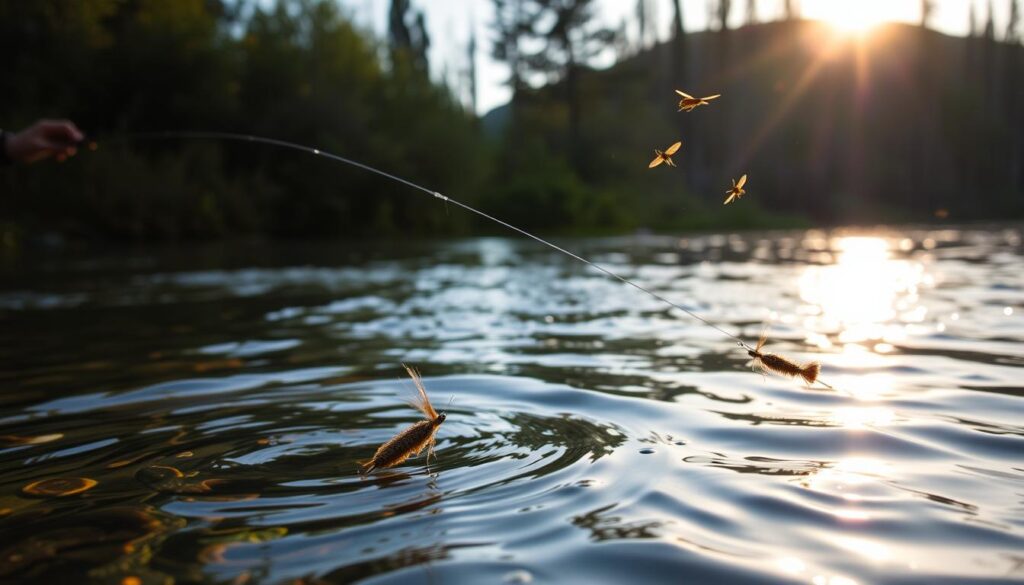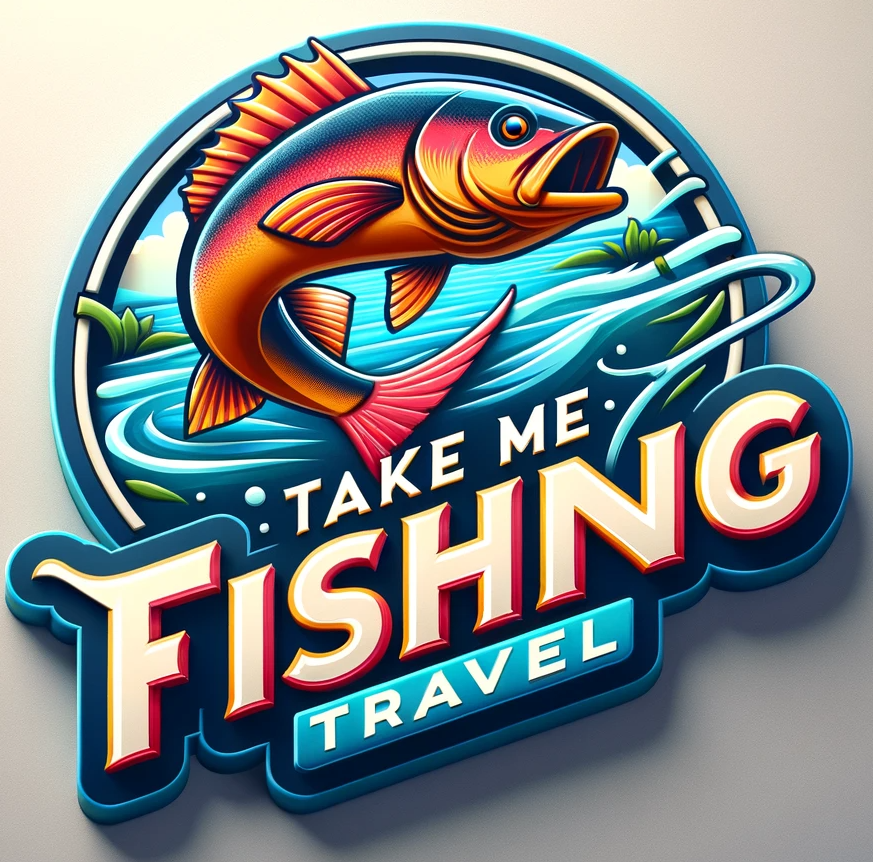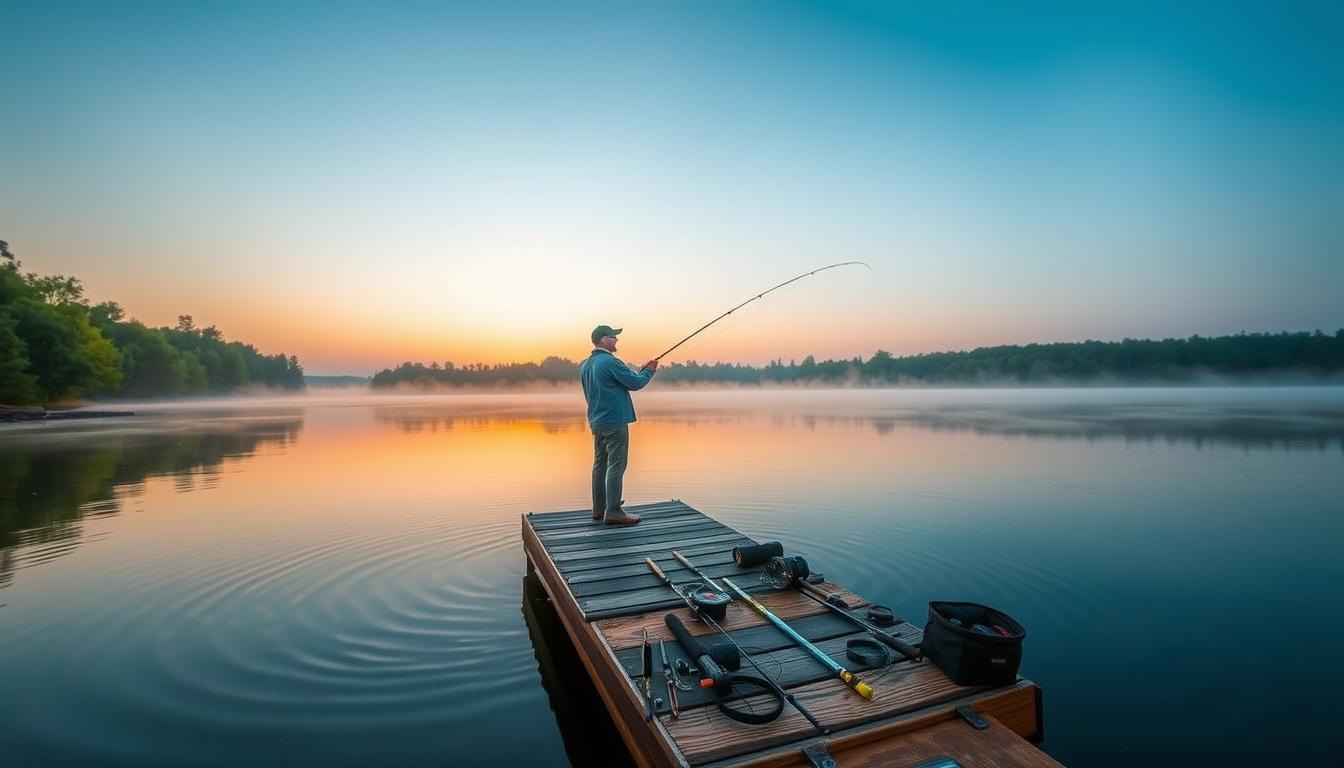This post contains affiliate links.
Imagine a peaceful river, the beauty of nature, and the excitement of catching a big trout. Fly fishing is more than a sport; it’s an art and a way to connect with the wild. It’s perfect for everyone, from beginners to seasoned anglers.
On the riverbank, you remember advice from experts like Tom Rosenbauer and Hilary Hutcheson. They tell you to watch how fish act before you cast. Craig Mathews says success in fly fishing comes with time and hard work.
Learning to tie knots and practicing casting are key steps. Pat McCabe and Jeff Currier can show you how. John Juracek reminds us that skill in casting matters most. This dedication helps fly fishing become a meaningful experience with nature.
Key Takeaways
- 80% of big trout are caught within a 20-foot cast.
- Different tiers of weighted flies target various water column levels.
- Trout prefer to rise to feed rather than move sideways or dive.
- Clear Thingamabobbers spook fewer fish compared to colored indicators.
- Utilize a 15-foot leader to minimize spooking trout during casting.
- Identifying windows in turbulent water boosts spotting efficiency.
- Downstream presentations are favored when dry-fly fishing for wary trout.
Understanding Trout Behavior
Fly fishing success comes from knowing how trout behave. They have special eating habits and instincts. These are key to any good fishing plan.
Trout face upstream to eat aquatic insects. They show patterns we can predict. A lot of the time, getting trout to bite depends on how the angler presents the fly. Not just on the fly itself. Statistics show that angler mistakes in presentation are the main problem 99% of the time.
Observing Before Casting
Start with careful watching. Look for signs like trout noses popping up. This means they’re eating mayflies. Seeing fins or tails means they’re feeding below the surface. Knowing these signs helps us understand trout better.
“By watching trout behavior, anglers can tailor their fly pattern selection, improving their chances of success exponentially.”—Tom Rosenbauer, Fly Fishing Expert
To fish well, sneak up from downstream. Cast your line upstream. Stay low to hide from the trout. Wearing earth tones also helps you blend in. This improves your chances of catching a fish.
Reacting to Natural Hatches
Responding quickly to hatches makes a big difference. Craig Mathews talks about choosing the right fly for current hatches. Like using Comparadun or Sparkle Dun flies for mayflies. Or an elk hair caddis for caddis flies.
Being flexible is key in famous fly fishing spots. Knowing when big fish eat is crucial. It’s often early in the morning, late in the evening, or at night. This shows how smart fish are and why understanding them helps you fish better.
Talking with local fly shops or looking up online reports helps a lot. They give tips on water conditions and what insects are hatching. For gear and tips on what to bring, check out this guide.
The Importance of Practice
Practice leads to perfection in fly fishing. Experts like Steve McFarland and Jeff Currier know this well. They recommend practicing knots often. This boosts confidence when changing flies out in nature. McFarland also suggests practicing casting on the lawn. It’s a stress-free way to get better at casting. This kind of practice builds muscle memory, which helps a lot when fishing.

Perfecting Your Knots
Knowing how to tie various fly fishing knots is key. All anglers, new and old, should master knots like the Improved Clinch Knot and the Surgeon’s Knot. Doing this strengthens the line’s hold and lessens break-offs. Try practicing these knots during your free time. It’ll make you quicker and more efficient when fishing.
Lawn Casting Sessions
Lawn casting is great for learning fly casting instructions stress-free. It’s good to use a 9′ 5wt fly rod for different fishing situations. Start with simple overhead and roll casts. Practicing in this setting improves your distance and accuracy. Keep at it until your casting is fluid and rhythmic. Then, you’ll see a big improvement next time you’re on the water.
Fly Casting Techniques
A good cast doesn’t just get the fly where you want it. It also makes the fly look like real prey to the fish.The Basic Overhead Cast
The Basic Overhead Cast is a core skill. It uses a smooth ‘ten-to-two’ motion. Done right, it’s as graceful as a dance.This cast gets your muscles and timing right for harder moves. Grip and how you move the rod are super important. They keep the rod’s tip straight, making your cast work better.
Roll Cast Emphasis
What if you can’t do a full cast? Use the Roll Cast. It’s great when you’re near trees or rocks.The key is to roll your line smoothly on the water. This cast is good for sneaky, quiet fly presentations. It keeps fish like trout from getting scared in clear, shallow water.
Mastering the Double Haul
The Double Haul is awesome for salmon fishing. It lets you cast farther and handle wind better. Your other hand helps speed up the line for these long casts.Most of your casting power comes from this hand move. Getting it right changes everything. It makes your rod work harder on both the back and forward casts. This means your casts go further.
Loop control is really important but often ignored. Experts like Joe Humphreys stress this. Changing your loops for different situations can make you much better.Practicing loop size and shape can sharpen your skills. Try using Hula Hoops to see your progress. This makes practice fun and really helps you get better.
- Loop Control: Fundamental for effective casting
- Basic Overhead Cast: Building block of fly casting techniques
- Roll Cast: Perfect for tight spaces
- Double Haul: Maximizes distance and power
Choosing the Right Fly
Choosing the perfect fly involves a mix of science, art, and sometimes, luck. Many factors influence your success, like seasonal shifts and the types of bugs around. Skilled fishers use their understanding of bugs, weather, and fish habits to pick wisely.
Knowing about bugs can really step up your fly fishing game. For example, Fulling Mill hooks are a big help in choosing the right bait for the fish you’re after. You need to think about the fly’s shape, weight, and color. This helps it look like what the fish are eating. Whether you’re fishing with dries, dry droppers, or indicators, matching your tactics to the fish’s current activities is key.
Each fishing condition calls for a different strategy. In clear waters, using flies that blend in works best. But in murky waters, bright and shiny flies get noticed. Depending on the season and water temp, you might choose slow nymphs or lively streamers.
Deciding between dry and wet flies can make all the difference. Dry flies float, mimicking adult bugs and luring fish upwards. Wet flies, like nymphs, sink and look like bugs in the water, which can up your chances of a catch.
Adjusting fly color based on where you are and the day’s weather is also vital. Bright flies shine on sunny days, while darker ones are better when it’s cloudy. Getting these details right can make your fishing trip a success or a letdown.
Expert anglers learn from every outing, using fly tying tutorials and noticing how trout respond to different conditions. They use this knowledge to improve their fishing, mastering both the technique and the art of the sport.
Effective Nymphing Strategies
Nymphing is a top method in fly fishing techniques. It’s really effective for catching sneaky trout. About 80% of fishers say it works well. Let’s check out some pro tips and tricks.

Weighting Your Nymphs
When fishing for trout, getting it right is everything. Trout like to hang out at the bottom, up to 12 inches deep. Using weighted flies helps your nymph get down quickly, in both fast water and deep spots. Landon Mayer, a pro guide, suggests using a few weights to keep your nymph from scaring the fish. A little extra weight makes sure your fly fishes where the trout are.
In swift waters, set your strike indicator to double the water’s depth. This tip makes sure your nymph gets to where the trout feed, fast and efficiently.
Using Indicators
Indicators are key in trout fishing tactics. A clear Thingamabobber is great because it’s stealthy and sensitive. It lets you feel when a trout barely touches your bait. Be ready to strike as soon as the indicator moves. Don’t miss out on catching a fish!
Trying nymph fishing without an indicator can be smart in shallow or even-flowing waters. The European nymphing style is becoming more popular. It’s seen as more effective than traditional methods.
Nymphing involves lots of techniques, like using special indicators for depth control or choosing the right bead type. Your flies, whether they mimic or attract, must match the depth and flow of the water. This detail-oriented approach leads to successful fishing.
Nymphing is more than just a fishing method. It is vital for fishing trout all year round. Learn the small details, adapt when conditions change, and improve your technique with each cast.
Fly Fishing Gear Essentials
Preparing for your next fly fishing trip means getting the right fly fishing gear essentials. This gear is key for success, whether at famous fly fishing spots or local streams.
Rods and Reels
Fly rods are labeled by weight, from 00 to 16. This tells you about their power and control. For beginners fishing in fresh water, a 5-weight, 9-foot rod is best. It offers a good balance for different fish. Rods vary for small brook trout or big saltwater fish. Fly reels also differ. They come with disc drag or click and pawl systems for line control.
It’s important to match your rod and reel well. This enhances their performance. Look for large arbor reels for fast line retrieval. This is crucial for catching big fish. For saltwater fishing, choose a reel with a sealed disc drag. This helps prevent damage from salt.
Polarized Sunglasses
Experts like Bob White never fish without polarized sunglasses. These glasses reduce water glare. They let you see into the water better. Think of them as a valuable tool that reveals fish movements.
High-quality polarized sunglasses are essential. They could be the difference in a successful fishing trip. When preparing for a fishing trip, remember these glasses. They help you see deeper and catch more fish.
Choosing the right rod, reel, and polarized sunglasses is crucial for fly fishing. Pick your gear carefully to enhance your fishing experience. Fish smartly with the right equipment!
Stream and River Tactics
Fly fishing in streams and rivers requires knowing about water flows and fish habits. Both beginners and seasoned fishers improve by learning key strategies. These techniques boost your fishing success.
Reading Water Currents
For newcomers, it’s crucial to understand water currents. Landon Mayer, a well-known angler, says watching water flow and speed helps find trout. Fish like slower waters to save energy. They hide behind rocks or close to banks. Finding these spots makes your casts more successful.
Identifying Feeding Lanes
Feeding lanes are where trout wait for their meals. Spotting these paths can up your fishing game. Trout stay in lanes where currents bring food directly to them. Knowing where trout look, especially their vertical view, can make your flies seem real. A good fly placement might trick even wary fish.
Success in fishing rivers and streams depends on knowing how water moves and fish behave. Using these techniques, fishers can get better at fly fishing. They can also sharpen their skills in salmon fishing.
| Equipment | Preference |
|---|---|
| Rod | 8ft 3wt |
| Fly Patterns | F-Flies, Quill Plume Tips, Elk Hair Sedges |
| Leaders | 7ft 5X and 6X tippet |
Fly Fishing Tips and Tricks
Fly fishing success is more than just luck. It needs careful planning and understanding the environment. Experts like Hilary Hutcheson tell us being organized is key to doing well on the water. This preparation boosts your confidence, smoothing the way for effective fishing.
Preparation and Planning
Getting ready for fly fishing isn’t just about your gear. It involves knowing the water, the weather, and what the fish are doing. Beginners should start with easier fishing spots to gain confidence. They should also have the right tools, like polarized sunglasses for clear vision, and know the basic fly fishing techniques. For example, using light flies or bead-head patterns works well for nymphing in fast currents.
Shadowing Expert Anglers
Learning from expert anglers also helps improve your skills. Kirk Deeter shares strategies that provide deep insights into fly fishing. Watching them manage their gear and move quietly without scaring the fish can really boost your abilities. You’ll learn things like the roll cast for tight places and how to use the Wooly Bugger effectively.
Mixing steady preparation with guidance from seasoned anglers leads to a strong understanding of fly fishing. This combination helps you master the essentials and subtle tactics, making your fishing trips more successful. For additional fishing tips and strategies, check out more insights on catching more fish at the angler’s edge.
FAQ
What are the most crucial fly fishing techniques for beginners?
Why is observing trout behavior important before casting?
How can I adapt my technique to match natural hatches?
What are some practical ways to practice fly casting and tying knots?
Can you explain the different fly casting techniques and their importance?
How should I go about selecting the right fly?
What are effective nymphing strategies to catch trout?
What are the essential pieces of fly fishing gear I need?
How can I read water currents and identify feeding lanes effectively?
What preparation and planning tips can improve my fly fishing outings?
This post contains affiliate links.

